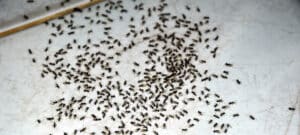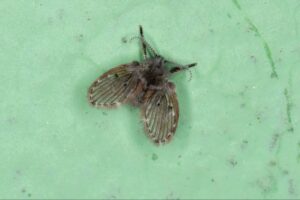Home / Blog / bugs / What Are These Tiny Orange Bugs in My House?
What Are These Tiny Orange Bugs in My House?

Scientifically reviewed by Rachel Maldonado
-Published on February 10, 2025
-Updated on December 3, 2025
What Are These Tiny Orange Bugs in My House?
“Good night, sleep tight, and don’t let the bedbugs bite” might be a familiar saying, but what if those tiny culprits aren’t actually bed bugs – but are perhaps something a little more vibrantly colored?
If you’ve been seeing tiny orange bugs scuttling around your house, don’t be alarmed. These little intruders can be a real nuisance, but you’ve got to understand what they are and how to handle them.
It’s time to play “tiny bug detective.” Let’s explore the most likely suspects so you can figure out your next steps.
What Are These Tiny Orange Bugs?

When you spot tiny orange bugs in your house, the usual suspects include thrips, clover mites, red spider mites, and fleas.
However, the most common culprits are chiggers, which are tiny pests that can cause big headaches – we’ll explain them in more detail below.
But before we do, know that there’s a chance that you could be dealing with another type of pest. Here are some contenders:
Thrips
Thrips are slender, tiny insects that are usually less than 1/16 of an inch long. They come in various colors, including orange. These warm-weather pests are often found on plants, both indoors and outdoors. They feed on plant sap, which can damage your plants and cause them to wilt or develop discolored spots.
Thrips themselves don’t pose a direct threat to humans, but their presence can indicate a broader pest problem. You might find them in your house if you have a lot of indoor plants or if they’ve hitched a ride inside from your garden.
Clover Mites
Clover mites are another possible tiny orange bug infestation. They are reddish-orange, oval-shaped, and about the size of a pinhead.
Clover mites don’t pose a health risk to humans, but they can be a nuisance when they invade homes in large numbers. They often enter houses in the fall and spring when the weather changes.
Clover mites feed on clover, grasses, and other plants, which is why you’re more likely to see them around window sills or in rooms that receive plenty of sunlight. These bugs can leave red stains when crushed, which can be annoying to clean up.
Red Spider Mites
Red spider mites are microscopic arachnids that live on the undersides of leaves and can spin fine webs over them. These mites are usually red but can also be orange. They feed by piercing plant cells and sucking out the contents, which can lead to yellow or brown spots on leaves and eventual plant death.
Red spider mites can infest houseplants and garden plants alike. While they don’t bite humans, their presence can signal that your plants are stressed and need help.
Fleas
Fleas are tiny, wingless insects that are reddish-brown in color and can sometimes (though not often) appear orange. Fleas feed on the blood of animals and humans, causing itchy bites and potentially spreading diseases.
If you have pets, fleas are a likely source of tiny orange bugs in your house.
The Most Likely Culprit – Chiggers
Chiggers are the larvae of mites belonging to the Trombiculidae family. These pests are barely visible to the naked eye, measuring only about 1/150th of an inch. They are usually orange or red and thrive in grassy and wooded areas.
Chiggers don’t live indoors for long, but they can bite humans and cause intense itching. The bites usually occur in areas where clothing is tight against the skin, such as around the waist or ankles. If you’ve recently spent time outdoors, chiggers could very well be the tiny orange bugs you’re seeing.
Chiggers can be challenging to identify due to their small size. They are often mistaken for other small red or orange bugs like the ones we already told you about.
Chiggers are nearly microscopic, and their bright red or orange color makes them easier to spot on light-colored surfaces. They move quickly and are often found in groups. Unlike adult mites, chiggers do not feed on plants or animals; instead, they inject digestive enzymes into the skin of their host, which causes severe itching.
Dealing With Chigger Bites
Chigger bites are incredibly itchy and can cause red, pimple-like bumps on the skin. The itching can last for several days and is often worse than mosquito bites. The bites commonly appear in clusters or lines and are usually found in areas where clothing fits snugly.
If you suspect chigger bites, there are a few steps you can take to alleviate the itching and discomfort.
Wash the affected area with soap and water as soon as possible to remove any remaining chiggers. Applying an over-the-counter anti-itch cream or taking an antihistamine can help reduce itching. In severe cases, you may need to consult a doctor for prescription medication.
How to Keep Tiny Orange Bugs Out of Your House
Prevention is crucial when it comes to managing any kind of tiny orange bugs like chiggers, thrips, clover mites, and red spider mites. Here are some effective strategies to keep them at bay.
Maintain a Clean Home
Keeping your home clean and free of clutter can help prevent bugs from finding places to hide. Regularly vacuum carpets, rugs, and upholstery to remove any potential pests. Pay close attention to areas where your pets spend time, as fleas can easily hide in pet bedding and furniture.
Seal Entry Points
Tiny orange bugs can enter your home through small cracks and gaps in doors, windows, and foundations. Inspect your home for any potential entry points and seal them with caulk or weatherstripping. Installing screens on windows and doors can also help keep bugs out.
Manage Outdoor Spaces
Since many of these pests come from the outdoors, maintaining your yard and garden is essential. Keep grass and shrubs trimmed, and remove any piles of leaves or debris where bugs might hide. Consider using insect-repellent plants or natural predators to keep pest populations under control.
Use Natural Repellents
In some cases, natural repellents can help keep bugs away from your home. Essential oils like peppermint, tea tree, and eucalyptus have insect-repelling properties. You can create a homemade spray by mixing a few drops of essential oil with water and spraying it around entry points and areas where you’ve seen bugs.
Call the Pros
While DIY methods can be effective in managing small infestations, there are times when professional help is necessary. If you’re dealing with a large or persistent infestation, it’s best to call a pest control service.
Professional pest control services, like our team at Hawx, have the expertise and resources to handle severe infestations. They can identify the specific type of pest you’re dealing with and develop a customized treatment plan. Professionals also have access to more potent and effective treatments that may not be available to the public.
Don’t Worry About Tiny Orange Bugs – Call Hawx
Dealing with tiny orange bugs in your house can be a frustrating experience, but understanding what you’re up against is the first step to resolving the problem. Whether it’s chiggers, thrips, clover mites, red spider mites, or fleas, each pest requires a different approach to management and prevention.
If you’re struggling with an infestation and need professional help, consider joining our family of satisfied customers at Hawx Pest Control. Our team of experts is dedicated to providing effective and environmentally friendly solutions to keep your home pest-free.
Contact us today to learn more about our services and how we can help you reclaim your home from unwanted intruders.
Related Articles
Visit our blog to learn more.
→







